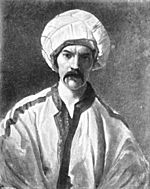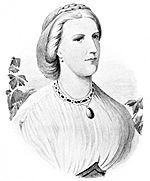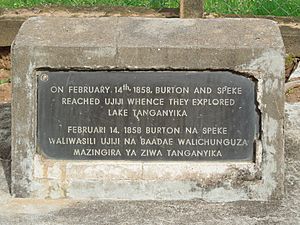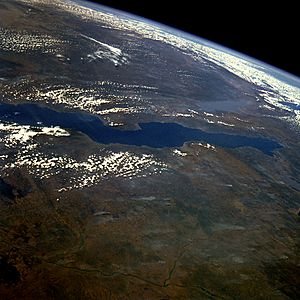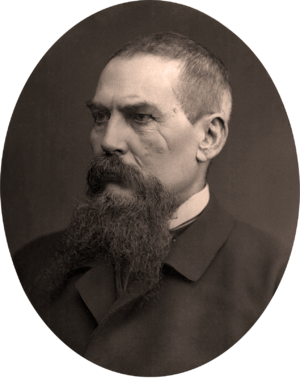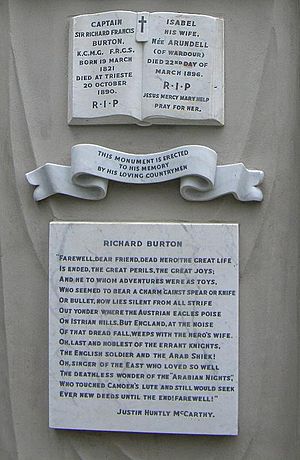Richard Francis Burton facts for kids
Quick facts for kids
Richard Francis Burton
KCMG FRGS
|
|
|---|---|
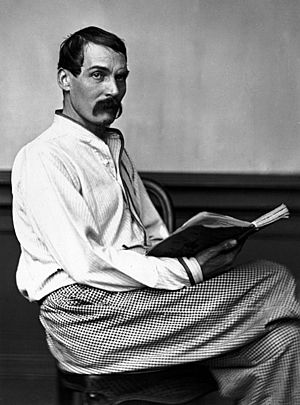
Burton in 1864
|
|
| Diplomatic posts | |
| British consul in Fernando Pó | |
| British consul in Santos | |
| British consul in Damascus | |
| British consul in Trieste | |
| Personal details | |
| Born | 19 March 1821 Torquay, Devon, England |
| Died | 20 October 1890 (aged 69) Trieste, Austria-Hungary |
| Spouse |
Isabel Arundell
(m. 1861) |
| Alma mater | Trinity College, Oxford |
| Signature | |
| Nickname | Ruffian Dick |
| Military service | |
| Allegiance | British Empire |
| Branch/service | Bombay Army |
| Years of service | 1842–1861 |
| Rank | Captain |
| Battles/wars | Crimean War |
| Awards | Knight Commander of the Order of St Michael and St George and Crimea Medal |
| Writing career | |
| Pen name |
|
Sir Richard Francis Burton KCMG FRGS (/ˈbɜːrtən/; 19 March 1821 – 20 October 1890) was a British explorer, writer, orientalist scholar, and soldier. He was famed for his travels and explorations in Asia, Africa, and the Americas, as well as his extraordinary knowledge of languages and cultures. According to one count, he spoke twenty-nine languages.
Burton's best-known achievements include: a well-documented journey to Mecca in disguise, at a time when non-Muslims were forbidden access on pain of death; a translation of One Thousand and One Nights (commonly called The Arabian Nights in English after early translations of Antoine Galland's French version); and a journey with John Hanning Speke as the first Europeans to visit the Great Lakes of Africa in search of the source of the Nile.
His works and letters extensively criticised colonial policies of the British Empire, even to the detriment of his career. Although he aborted his university studies, he became a prolific and erudite author and wrote numerous books and scholarly articles about subjects including human behaviour, travel, falconry, fencing, and ethnography. A characteristic feature of his books is the copious footnotes and appendices containing remarkable observations and information. William Henry Wilkins wrote: "So far as I can gather from all I have learned, the chief value of Burton’s version of The Scented Garden lay not so much in his translation of the text, though that of course was admirably done, as in the copious notes and explanations which he had gathered together for the purpose of annotating the book. He had made this subject a study of years. For the notes of the book alone he had been collecting material for thirty years, though his actual translation of it only took him eighteen months."
Burton was a captain in the army of the East India Company, serving in India, and later briefly in the Crimean War. Following this, he was engaged by the Royal Geographical Society to explore the east coast of Africa, where he led an expedition guided by locals and was the first European known to have seen Lake Tanganyika. In later life, he served as British consul in Fernando Pó (now Bioko, Equatorial Guinea), Santos in Brazil, Damascus (now Syria), and finally in Trieste (now Italy). He was a Fellow of the Royal Geographical Society and was awarded a knighthood in 1886.
Biography
Early life and education (1821–1841)
Burton was born in Torquay, Devon, at 21:30 on 19 March 1821; in his autobiography, he incorrectly claimed to have been born in the family home at Barham House in Elstree in Hertfordshire. He was baptised on 2 September 1821 at Elstree Church in Borehamwood, Hertfordshire. His father, Lt.-Colonel Joseph Netterville Burton, of the 36th Regiment, was an Irish-born British army officer of Anglo-Irish extraction who through his mother's family—the Campbells of Tuam—was a first cousin of Lt.-Colonel Henry Peard Driscoll and Mrs Richard Graves. Richard's mother, Martha Baker, was the daughter and co-heiress of a wealthy English squire, Richard Baker (1762–1824), of Barham House, Hertfordshire, for whom he was named. Burton had two siblings, Maria Katherine Elizabeth Burton (who married Lt.-General Sir Henry William Stisted) and Edward Joseph Netterville Burton, born in 1823 and 1824, respectively.
Burton's family travelled extensively during his childhood and employed various tutors to educate him. In 1825, they moved to Tours in France. In 1829, Burton began a formal education at a preparatory school in Richmond Green in Richmond, Surrey, run by Reverend Charles Delafosse. His family travelled between England, France, and Italy. Burton showed a talent to learn languages and quickly learned French, Italian, Neapolitan and Latin, as well as several dialects. During his youth, he learned the rudiments of the Romani language. The peregrinations of his youth may have encouraged Burton to regard himself as an outsider for much of his life. As he put it, "Do what thy manhood bids thee do, from none but self expect applause".
Burton matriculated at Trinity College, Oxford, on 19 November 1840. Before getting a room at the college, he lived for a short time in the house of William Alexander Greenhill, then doctor at the Radcliffe Infirmary. Here, he met John Henry Newman, whose churchwarden was Greenhill. Despite his intelligence and ability, Burton was antagonised by his teachers and peers. During his first term, he is said to have challenged another student to a duel after the latter mocked Burton's moustache. Burton continued to gratify his love of languages by studying Arabic; he also spent his time learning falconry and fencing. In April 1842, he attended a steeplechase in deliberate violation of college rules and subsequently dared to tell the college authorities that students should be allowed to attend such events. Hoping to be merely "rusticated", he was instead permanently expelled from Trinity College.
According to Ed Rice, speaking on Burton's university days, "He stirred the bile of the dons by speaking real—that is, Roman—Latin instead of the artificial type peculiar to England, and he spoke Greek Romaically, with the accent of Athens, as he had learned it from a Greek merchant at Marseilles, as well as the classical forms. Such a linguistic feat was a tribute to Burton's remarkable ear and memory, for he was only a teenager when he was in Italy and southern France."
Army career (1842–1853)
In his own words, "fit for nothing but to be shot at for six pence a day", Burton enlisted in the army of the East India Company at the behest of his ex-college classmates who were already members. He hoped to fight in the first Afghan war, but the conflict was over before he arrived in India. He was posted to the 18th Bombay Native Infantry based in Gujarat and under the command of General Charles James Napier. While in India, he became a proficient speaker of Hindustani, Gujarati, Punjabi, Sindhi, Saraiki and Marathi as well as Persian and Arabic. His studies of Hindu culture had progressed to such an extent that "my Hindu teacher officially allowed me to wear the janeo (Brahmanical Thread)". Him Chand, his gotra teacher, a Nagar Brahmin, could have been an apostate. Burton had a documented interest (and actively participated) in the cultures and religions of India. This was one of many peculiar habits that set him apart from other soldiers. While in the army, he kept a large menagerie of tame monkeys in the hopes of learning their language, accumulating sixty "words". He also earned the name "Ruffian Dick" for his "demonic ferocity as a fighter and because he had fought in single combat more enemies than perhaps any other man of his time".
According to Ed Rice, "Burton now regarded the seven years in India as time wasted." Yet, "He had already passed the official examinations in six languages and was studying two more and was eminently qualified." His religious experiences were varied, including attending Catholic services, becoming a Nāgar Brāhmin, adopting Sikhism, conversion to Islam, and undergoing chillá for Qadiri Sufism.
First explorations and journey to Mecca (1851–53)
Burton's pilgrimage to Medina and Mecca in 1853, was his realization of "the plans and hopes of many and many a year...to study thoroughly the inner life of the Moslem." Traveling through Alexandria in April, then Cairo in May, where he stayed in June during Ramadan, Burton first donned the guise of a Persian mirza, then a Sunnī "Shaykh, doctor, magician and dervish. Accompanied by an Indian boy slave called Nūr, Burton further equipped himself with a case for carrying the Qur'ān, but instead had three compartments for his watch and compass, money, and penknife, pencils, and numbered pieces of paper for taking notes. His diary he kept in a break pocket, unseen. Burton traveled onwards with a group of nomads to Suez, sailed to Yambu, and joined a caravan to Medina, where he arrived on 27 July, earning the title Zair. Departing Medina with the Damascus caravan on 31 August, Burton entered Mecca on 11 September. There, he participated in the Tawaf, traveled to Mount Arafat, and participated in the Stoning of the Devil, all the while taking notes on the Kaaba, its Black Stone, and the Zamzam Well. Departing Mecca, he journeyed to Jeddah, back to Cairo, returning to duty in Bombay. In India, Burton wrote his Personal Narrative of a Pilgrimage to El-Medinah and Meccah. Of his journey, Burton wrote, "at Mecca there is nothing theatrical, nothing that suggests the opera, but all is simple and impressive...tending, I believe, after its fashion, to good."
Motivated by his love of adventure, Burton got the approval of the Royal Geographical Society for an exploration of the area, and he gained permission from the board of directors of the East India Company to take leave from the army. His seven years in India gave Burton a familiarity with the customs and behaviour of Muslims and prepared him to attempt a Hajj (pilgrimage to Mecca and, in this case, Medina). It was this journey, undertaken in 1853, which first made Burton famous. He had planned it whilst travelling disguised among the Muslims of Sindh, and had laboriously prepared for the adventure by study and practice.
Although Burton was certainly not the first non-Muslim European to make the Hajj (Ludovico di Varthema did this in 1503 and Johann Ludwig Burckhardt in 1815), his pilgrimage is the most famous and the best documented of the time. He adopted various disguises including that of a Pashtun to account for any oddities in speech, but he still had to demonstrate an understanding of intricate Islamic traditions, and a familiarity with the minutiae of Eastern manners and etiquette. Burton's trek to Mecca was dangerous, and his caravan was attacked by bandits (a common experience at the time). As he put it, though "... neither Koran or Sultan enjoin the death of Jew or Christian intruding within the columns that note the sanctuary limits, nothing could save a European detected by the populace, or one who after pilgrimage declared himself an unbeliever". The pilgrimage entitled him to the title of Hajji and to wear the green head wrap. Burton's own account of his journey is given in A Personal Narrative of a Pilgrimage to Al-Madinah and Meccah.
Burton sat for the examination as an Arab linguist. The examiner was Robert Lambert Playfair, who distrusted Burton. As Professor George Percy Badger knew Arabic well, Playfair asked Badger to oversee the exam. Having been told that Burton could be vindictive, and wishing to avoid any animosity should Burton fail, Badger declined. Playfair conducted the tests; despite Burton's success living like an Arab, Playfair had recommended to the committee that Burton be failed. Badger later told Burton that "After looking [Burton's test] over, I [had] sent them back to [Playfair] with a note eulogising your attainments and ... remarking on the absurdity of the Bombay Committee being made to judge your proficiency inasmuch as I did not believe that any of them possessed a tithe of the knowledge of Arabic you did."
Early explorations (1854–55)
In May 1854, Burton traveled to Aden in preparation for his Somaliland Expedition, supported by the Royal Geographical Society. Other members included G.E. Herne, William Stroyan, and John Hanning Speke. Burton undertook the expedition to Harar, Speke investigated the Wady Nogal, while Herne and Stroyan stayed on at Berbera. According to Burton, "A tradition exists that with the entrance of the first [white] Christian Harar will fall." With Burton's entry, the "Guardian Spell" was broken.
This Somaliland Expedition lasted from 29 October 1854 to 9 February 1855, with much of the time spent in the port of Zeila, where Burton was a guest of the town's Governor al-Haji Sharmakay bin Ali Salih. Burton, "assuming the disguise of an Arab merchant" called Haji Mirza Abdullah, awaited word that the road to Harar was safe. On 29 December, Burton met with Gerard Adan in the village of Sagharrah, when Burton openly proclaimed himself an English officer with a letter for the Amīr of Harar. On 3 January 1855, Burton made it to Harar, and was graciously met by the Amir. Burton stayed in the city for ten days, officially a guest of the Amir but in reality his prisoner. The journey back was plagued by lack of supplies, and Burton wrote that he would have died of thirst had he not seen desert birds and realized they would be near water. Burton made it back to Berbera on 31 January 1855.
Following this adventure, Burton prepared to set out in search of the source of the Nile, accompanied by Lieutenant Speke, Lieutenant G. E. Herne and Lieutenant William Stroyan and a number of Africans employed as bearers and expedition guides . The schooner HCS Mahi delivered them to Berbera on 7 April 1855. While the expedition was camped near Berbera, his party was attacked by a group of Somali waranle ("warriors") belonging to Isaaq clan. The officers estimated the number of attackers at 200. In the ensuing fight, Stroyan was killed and Speke was captured and wounded before he managed to escape. Burton was wounded in the face with a javelin. This wound left a notable scar that can be easily seen on portraits and photographs. He escaped; however, it was no surprise then that he found the Somalis to be a "fierce and turbulent race". The failure of this expedition was viewed harshly by the authorities, and a two-year investigation was set up to determine to what extent Burton was culpable for this disaster. While he was largely cleared of any blame, this did not help his career. He describes the harrowing attack in First Footsteps in East Africa (1856).
After recovering from his wounds in London, Burton traveled to Constantinople during the Crimean War, seeking a commission. He received one from General W.F. Beatson, as the Chief of staff for "Beatson's Horse", popularly called the Bashi-bazouks, and based in Gallipoli. Burton returned after an incident which disgraced Beatson, and implicated Burton as the instigator of a "mutiny", damaging his reputation.
Exploring the African Great Lakes (1856–1860)
In 1856, the Royal Geographical Society funded another expedition for Burton and Speke, "and exploration of the then utterly unknown Lake regions of Central Africa." They would travel from Zanzibar to Ujiji along a caravan route established in 1825 by an Arab slave and ivory merchant. The Great Journey commenced on 5 June 1857 with their departure from Zanzibar, where they had stayed at the residence of Atkins Hamerton, the British consul, their caravan consisting of Baluchi mercenaries led by Ramji, 36 porters, eventually a total of 132 persons, all led by the caravan leader Said bin Salim. From the beginning, Burton and Speke were hindered by disease, malaria, fevers, and other maladies, at times both having to be carried in a hammock. Pack animals died, and natives deserted, taking supplies with them. Yet, on 7 November 1857, they made it to Kazeh, and departed for Ujiji on 14 Dec Speke wanted to head north, sure they would find the source of the Nile at what he later named Victoria Nyanza, but Burton persisted in heading west.
The expedition arrived at Lake Tanganyika on 13 February 1858. Burton was awestruck by the sight of the magnificent lake, but Speke, who had been temporarily blinded, was unable to see the body of water. By this point much of their surveying equipment was lost, ruined, or stolen, and they were unable to complete surveys of the area as well as they wished. Burton was again taken ill on the return journey; Speke continued exploring without him, making a journey to the north and eventually locating the great Lake Victoria, or Victoria Nyanza, on 3 August. Lacking supplies and proper instruments, Speke was unable to survey the area properly but was privately convinced that it was the long-sought source of the Nile. Burton's description of the journey is given in Lake Regions of Equatorial Africa (1860). Speke gave his own account in The Journal of the Discovery of the Source of the Nile (1863).
Burton and Speke made it back to Zanzibar on 4 March 1859, and left on 22 March for Aden. Speke immediately boarded HMS Furious for London, where he gave lectures, and was awarded a second expedition by the Society. Burton arrived London on 21 May, discovering "My companion now stood forth in his new colours, and angry rival." Speke additionally published What Led to the Discovery of the Source of the Nile (1863), while Burton's Zanzibar; City, Island, and Coast was eventually published in 1872.
Burton then departed on a trip to the United States in April 1860, eventually making it to Salt Lake City on 25 August. There he studied Mormonism and met Brigham Young. Burton departed San Francisco on 15 November, for the voyage back to England, where he published The City of the Saints and Across the Rocky Mountains to California.
Burton and Speke
A prolonged public quarrel followed, damaging the reputations of both Burton and Speke. Some biographers have suggested that friends of Speke (particularly Laurence Oliphant) had initially stirred up trouble between the two. Burton's sympathizers contend that Speke resented Burton's leadership role. Tim Jeal, who has accessed Speke's personal papers, suggests that it was more likely the other way around, Burton being jealous and resentful of Speke's determination and success. "As the years went by, [Burton] would neglect no opportunity to deride and undermine Speke's geographical theories and achievements".
Speke had earlier proven his mettle by trekking through the mountains of Tibet, but Burton regarded him as inferior as he did not speak any Arabic or African languages. Despite his fascination with non-European cultures, some have portrayed Burton as an unabashed imperialist convinced of the historical and intellectual superiority of the white race, citing his involvement in the Anthropological Society, an organization that established a doctrine of scientific racism. Speke appears to have been kinder and less intrusive to the Africans they encountered, and reportedly fell in love with an African woman on a future expedition.
The two men travelled home separately. Speke returned to London first and presented a lecture at the Royal Geographical Society, claiming Lake Victoria as the source of the Nile. According to Burton, Speke broke an agreement they had made to give their first public speech together. Apart from Burton's word, there is no proof that such an agreement existed, and most modern researchers doubt that it did. Tim Jeal, evaluating the written evidence, says the odds are "heavily against Speke having made a pledge to his former leader".
Speke undertook a second expedition, along with Captain James Grant and Sidi Mubarak Bombay, to prove that Lake Victoria was the true source of the Nile. Speke, in light of the issues he was having with Burton, had Grant sign a statement saying, among other things, "I renounce all my rights to publishing ... my own account [of the expedition] until approved of by Captain Speke or [the Royal Geographical Society]".
On 16 September 1864, Burton and Speke were scheduled to debate the source of the Nile at a meeting of the British Association for the Advancement of Science. On the day before the debate, Burton and Speke sat near each other in the lecture hall. According to Burton's wife, Speke stood up, said "I can't stand this any longer," and abruptly left the hall. That afternoon Speke went hunting on the nearby estate of a relative. He was discovered lying near a stone wall, felled by a fatal gunshot wound from his hunting shotgun. Burton learned of Speke's death the following day while waiting for their debate to begin. A jury ruled Speke's death an accident. An obituary surmised that Speke, while climbing over the wall, had carelessly pulled the gun after himself with the muzzle pointing at his chest. Alexander Maitland, Speke's only biographer, concurs.
Diplomatic service and scholarship (1861–1890)
On 22 January 1861, Burton and Isabel Arundel married in a quiet Catholic ceremony although he did not adopt the Catholic faith at this time. Shortly after this, the couple were forced to spend some time apart when he formally entered the Diplomatic Service as consul on the island of Fernando Po, now Bioko in Equatorial Guinea. This was not a prestigious appointment; because the climate was considered extremely unhealthy for Europeans, Isabel could not accompany him. Burton spent much of this time exploring the coast of West Africa, documenting his findings in Abeokuta and The Cameroons Mountains: An Exploration (1863), and A Mission to Gelele, King of Dahome (1864). He described some of his experiences, including a trip up the Congo River to the Yellala Falls and beyond, in his 1876 book Two trips to gorilla land and the cataracts of the Congo.
The couple were reunited in 1865 when Burton was transferred to Santos in Brazil. Once there, Burton travelled through Brazil's central highlands, canoeing down the São Francisco River from its source to the falls of Paulo Afonso. He documented his experiences in The Highlands of Brazil (1869).
In 1868 and 1869 he made two visits to the war zone of the Paraguayan War, which he described in his Letters from the Battlefields of Paraguay (1870).
In 1868 he was appointed as the British consul in Damascus, an ideal post for someone with Burton's knowledge of the region and customs. According to Ed Rice, "England wanted to know what was going on in the Levant," another chapter in The Great Game. Yet, the Turkish governor Mohammed Rashid 'Ali Pasha, feared anti-Turkish activities, and was opposed to Burton's assignment.
In Damascus, Burton made friends with Abdelkader al-Jazairi, while Isabel befriended Jane Digby, calling her "my most intimate friend." Burton also met with Charles F. Tyrwhitt-Drake and Edward Henry Palmer, collaborating with Drake in writing Unexplored Syria (1872).
However, the area was in some turmoil at the time with considerable tensions between the Christian, Jewish and Muslim populations. Burton did his best to keep the peace and resolve the situation, but this sometimes led him into trouble. On one occasion, he claims to have escaped an attack by hundreds of armed horsemen and camel riders sent by Mohammed Rashid Pasha, the Governor of Syria. He wrote, "I have never been so flattered in my life than to think it would take three hundred men to kill me." Burton eventually suffered the enmity of the Greek Christian and Jewish communities. Then, his involvement with the Sházlis, a group of Muslims Burton called "Secret Christians longing for baptism," which Isabel called "his ruin." He was recalled in August 1871, prompting him to telegram Isabel "I am recalled. Pay, pack, and follow at convenience."
Burton was reassigned in 1872 to the port city of Trieste in Austria-Hungary. A "broken man", Burton was never particularly content with this post, but it required little work, was far less dangerous than Damascus (as well as less exciting), and allowed him the freedom to write and travel.
In 1863 Burton co-founded the Anthropological Society of London with Dr. James Hunt. On 13 February 1886, Burton was appointed a Knight Commander of the Order of St Michael and St George (KCMG) by Queen Victoria.
He wrote a number of travel books in this period that were not particularly well received. These books include The Book of the Thousand Nights and a Night (1885) (popularly known as The Arabian Nights), The Perfumed Garden of the Shaykh Nefzawi (1886) and The Supplemental Nights to the Thousand Nights and a Night (seventeen volumes 1886–98).
Published in this period but composed on his return journey from Mecca, The Kasidah has been cited as evidence of Burton's status as a Bektashi Sufi. Deliberately presented by Burton as a translation, the poem and his notes and commentary on it contain layers of Sufic meaning that seem to have been designed to project Sufi teaching in the West. "Do what thy manhood bids thee do/ from none but self expect applause;/ He noblest lives and noblest dies/ who makes and keeps his self-made laws" is The Kasidah's most-quoted passage. As well as references to many themes from Classical Western myths, the poem contains many laments that are accented with fleeting imagery such as repeated comparisons to "the tinkling of the Camel bell" that becomes inaudible as the animal vanishes in the darkness of the desert.
Other works of note include a collection of Hindu tales, Vikram and the Vampire (1870); and his uncompleted history of swordsmanship, The Book of the Sword (1884). He also translated The Lusiads, the Portuguese national epic by Luís de Camões, in 1880 and, the next year, wrote a sympathetic biography of the poet and adventurer. The book The Jew, the Gipsy and el Islam was published posthumously in 1898 and was controversial for its criticism of Jews and for its assertion of the existence of Jewish human sacrifices. Burton's investigations into this had provoked hostility from the Jewish population in Damascus (see the Damascus affair). The manuscript of the book included an appendix discussing the topic in more detail, but by the decision of his widow, it was not included in the book when published.
Death
Burton died in Trieste early on the morning of 20 October 1890 of a heart attack. His wife Isabel persuaded a priest to perform the last rites, although Burton was not a Catholic, and this action later caused a rift between Isabel and some of Burton's friends. It has been suggested that the death occurred very late on 19 October and that Burton was already dead by the time the last rites were administered. On his religious views, Burton called himself an atheist, stating he was raised in the Church of England which he said was "officially (his) church".
Isabel never recovered from the loss. After his death she burned many of her husband's papers, including journals and a planned new translation of The Perfumed Garden to be called The Scented Garden, for which she had been offered six thousand guineas and which she regarded as his "magnum opus". She believed she was acting to protect her husband's reputation. However, a substantial quantity of his written materials have survived, and are held by the Huntington Library in San Marino, California, including 21 boxes of his manuscripts, 24 boxes of correspondence, and other material.
Isabel wrote a biography in praise of her husband.
The couple are buried in a tomb in the shape of a Bedouin tent, designed by Isabel, in the cemetery of St Mary Magdalen Roman Catholic Church Mortlake in southwest London. The coffins of Sir Richard and Lady Burton can be seen through a window at the rear of the tent, which can be accessed via a short fixed ladder. Next to the lady chapel in the church there is a memorial stained-glass window to Burton, also erected by Isabel; it depicts Burton as a medieval knight. Burton's personal effects and a collection of paintings, photographs and objects relating to him are in the Burton Collection at Orleans House Gallery, Twickenham. Among these is a small quartz stone from Mesopotamia, inscribed in supposed Kufic script, which has thus far resisted decipherment by experts.
Chronology

Works and correspondence
Burton published over 40 books and countless articles, monographs and letters. A great number of his journal and magazine pieces have never been catalogued. Over 200 of these have been collected in PDF facsimile format at burtoniana.org.
Brief selections from a variety of Burton's writings are available in Frank McLynn's Of No Country: An Anthology of Richard Burton (1990; New York: Charles Scribner's Sons).
See also
 In Spanish: Richard Francis Burton para niños
In Spanish: Richard Francis Burton para niños
- Selim Aga
- Mausoleum of Sir Richard and Lady Burton
- List of polyglots


